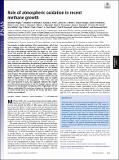Role of atmospheric oxidation in recent methane growth
Author(s)
Rigby, Matthew; Montzka, Stephen A.; White, James W. C.; Young, Dickon; O’Doherty, Simon; Lunt, Mark F.; Ganesan, Anita L.; Manning, Alistair J.; Simmonds, Peter G.; Salameh, Peter K.; Harth, Christina M.; Mühle, Jens; Weiss, Ray F.; Fraser, Paul J.; Steele, L. Paul; Krummel, Paul B.; McCulloch, Archie; Park, Sunyoung; Prinn, Ronald G; ... Show more Show less
DownloadRigby-2017-Role of atmospheric oxidation in re.pdf (982.0Kb)
PUBLISHER_POLICY
Publisher Policy
Article is made available in accordance with the publisher's policy and may be subject to US copyright law. Please refer to the publisher's site for terms of use.
Terms of use
Metadata
Show full item recordAbstract
The growth in global methane (CH₄) concentration, which had been ongoing since the industrial revolution, stalled around the year 2000 before resuming globally in 2007. We evaluate the role of the hydroxyl radical (OH), the major CH₄ sink, in the recent CH₄ growth. We also examine the influence of systematic uncertainties in OH concentrations on CH₄ emissions inferred from atmospheric observations. We use observations of 1,1,1- trichloroethane (CH₃CCl₃), which is lost primarily through reaction with OH, to estimate OH levels as well as CH₃CCl₃ emissions, which have uncertainty that previously limited the accuracy of OH estimates. We find a 64-70% probability that a decline in OH has contributed to the post-2007 methane rise. Our median solution suggests that CH₄ emissions increased relatively steadily during the late 1990s and early 2000s, after which growth was more modest. This solution obviates the need for a sudden statistically significant change in total CH₄ emissions around the year 2007 to explain the atmospheric observations and can explain some of the decline in the atmospheric ¹³CH₄/¹²CH₄ ratio and the recent growth in C₂H₆. Our approach indicates that significant OH-related uncertainties in the CH₄ budget remain, and we find that it is not possible to implicate, with a high degree of confidence, rapid global CH₄ emissions changes as the primary driver of recent trends when our inferred OH trends and these uncertainties are considered.
Date issued
2017-04Department
Massachusetts Institute of Technology. Center for Global Change Science; Massachusetts Institute of Technology. Department of Earth, Atmospheric, and Planetary SciencesJournal
Proceedings of the National Academy of Sciences
Publisher
National Academy of Sciences (U.S.)
Citation
Rigby, Matthew, Stephen A. Montzka, Ronald G. Prinn, James W. C. White, Dickon Young, Simon O’Doherty, Mark F. Lunt, et al. “Role of Atmospheric Oxidation in Recent Methane Growth.” Proceedings of the National Academy of Sciences 114, 21 (April 2017): 5373–5377 © 2017 National Academy of Sciences
Version: Final published version
ISSN
0027-8424
1091-6490